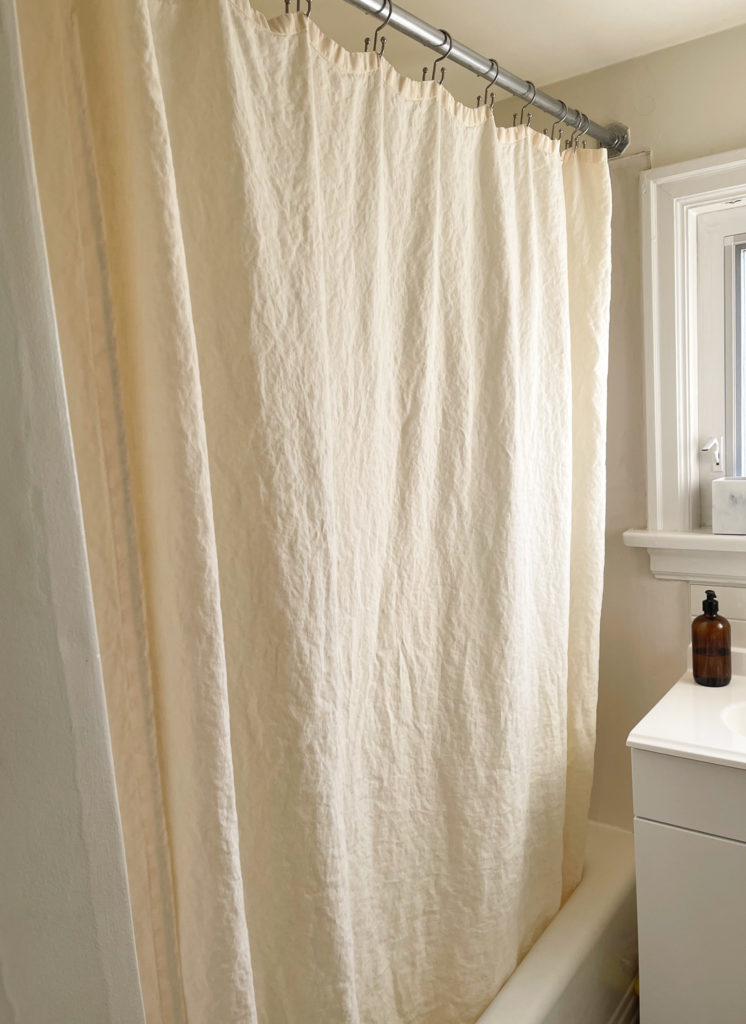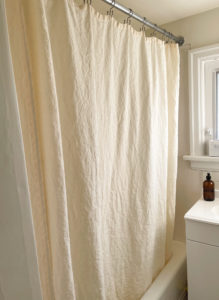PVC shower curtains (the most common shower curtain you will find in stores today) are bad for your health and the environment. They end up in landfills when they are thrown out. When they are being used in your shower they release a substantial amount of Volatile Organic Compounds (everyone can probably remember that “new shower curtain smell”), and these substances are linked to a host of diseases from respiratory irritation to liver and kidney damage. A 2008 study found that that “new shower curtain smell” includes 108 different types of volatile organic compounds being released into the air over a 28 day period! They also contain phthalates that have a host of endocrine-disrupting and other negative health impacts and which have been nicknamed “forever chemicals” because of how long they remain in the environment.
Eco-Friendly Shower Curtain Options
My desire to avoid these chemicals took me on a search for eco-friendly alternatives and I quickly discovered that there are a few different options in this space, at a significant range of prices (from $10 to $130). Eco-friendly shower curtains made from natural materials (such as linen, or hemp) can cost $130 Canadian dollars or more.
If you have the money in your budget, and a well-ventilated bathroom (or the time to wash your shower curtain every week), then these shower curtains are well worth the investment. However, you can also still have a shower curtain that does not release toxic VOC’s for a much more affordable price. In fact, I would recommend buying a more affordable eco-friendly shower curtain if you do not have a bathroom with good ventilation because of the tendency of natural fibre shower curtains to develop mold. In this case, the more affordable option is more durable and low-maintenance.
Back when I was living in an apartment with black mold and a poorly ventilated bathroom, I opted for a PEVA shower curtain from IKEA which is very affordable (costs $3), and which Ikea guarantees to be PVC-free. This worked wonderfully, and I was glad to not smell any of the typical smells that often come with new shower curtains when I hung it up in my shower. Later, when I moved into an apartment that was well-ventilated and wanted a nicer aesthetic for my bathroom, I opted for a more expensive ($129) hemp shower curtain from Dream Designs.
Because I have used both of these shower curtain options, I wanted to outline the pros and cons of each. I believe you should invest in a shower curtain like this if 1) your bathroom is well ventilated; 2) you have the time to wash it and 3) you care about bathroom aesthetics and interior design more than durability. The PEVA shower curtain from Ikea is definitely going to be the better choice if you are looking for something more durable, affordable, and still eco-friendly.
IKEA also has a newer eco-friendly option that costs a bit more ($10) and that is a recycled polyester shower curtain. PEVA, or polyethylene vinyl acetate, does not contain phthalates and will not off-gas VOCs nearly as much as PVC, but polyester is going to be an even better eco-friendly option with a similarly low chance of getting moldy compared to a natural fibre shower curtain made of hemp or linen.
Caring for a Natural Fibre Shower Curtain
The hemp shower curtain that I purchased from Dream Designs says on the care instructions that they recommend you wash it once a week week. I did not have time for this (who does!). Keep in mind every time you wash a shower curtain you have to take it off the hooks, which is very time consuming!
I ended up washing this shower curtain whenever I saw it was discoloured or looking like it needed a wash. This was roughly every three months. Because my current bathroom is well ventilated, I managed to get away with not washing it once a week and it did not develop mold for at least a year. However, after about a year of use and infrequent washes it did develop some small speckled mold spots at the bottom near where it retains the most moisture. Since the curtain is a light cream colour the mold spots do show and I was unable to get them to wash out (although there are some very small, barely visible spotted stains at the bottom from the occasional time I didn’t soak it in oxygen bleach for long enough and then put it in the dryer).
In order to kill the mold and remove stains, I recommend soaking the shower curtain in a bit of oxygen bleach dissolved in warm water.
It is also important to also make sure to keep the curtain open lengthwise (spread out) in order to give it a better chance to dry out every time after you take a shower. It dries quick, is lightweight, and it looks beautiful in a bathroom. If you have the money and desire to invest in this type of shower curtain, and understand these potential issues, I say go for it!
The Eco-Friendly Shower Curtain I Recommend For Most People
My top recommendation factoring in durability, quality, and eco-friendly criteria is the recently developed polyester shower curtain from IKEA. This is going to be your best bet for avoiding toxic VOC and phthalates while also getting something that is affordable and which can last for a long time in a shower setting without going moldy (and if it does, you can just throw it in the laundry machine!).
If you want an even more affordable option that still is relatively eco-friendly, you can opt for a PEVA shower curtain from IKEA.
The other good news is that neither of these options require shower curtain liners and should do an excellent job of keeping water away from your bathroom floor.
A Higher-End Option
The shower curtain I currently own is the hemp shower curtain from Dream Designs seen here in my bathroom:

Dream Designs also makes a linen shower curtain which is slightly less expensive. You can find linen or hemp shower curtains from other companies as well, or on Etsy. Or you can make your own!
A Note on Shower Curtain Liners
Please note that liners are not needed for either of these shower curtains, although a small amount of water may spray into the bathroom if you have particularly high water pressure. Make sure to angle the water away from the curtain because unlike plastic they are not entirely water-proof (this should not deter you from buying though, as they will work mostly the same as a PVC shower curtain).


 How to Find Deals Shopping Online
How to Find Deals Shopping Online